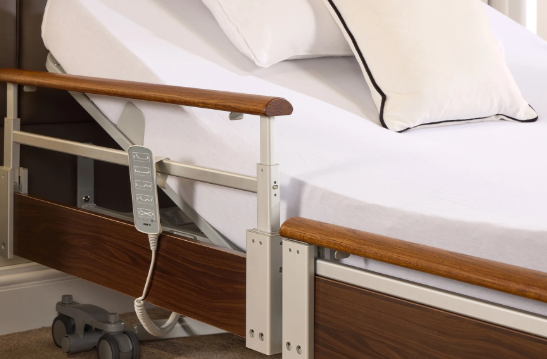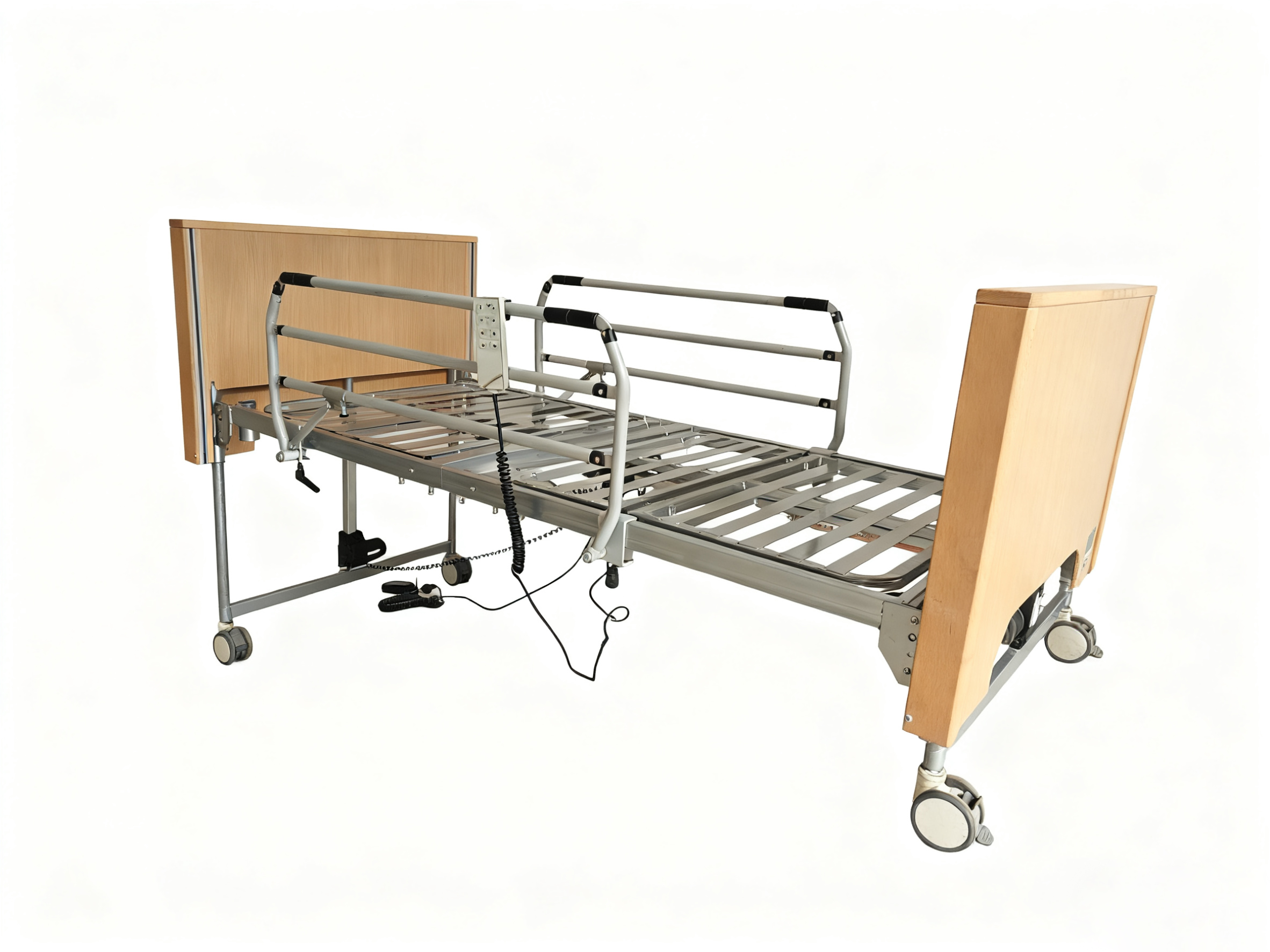5 Important Things To Know When Selecting Bed Safety Rails For Home Hospital Beds
Picking bed safety rails for a home hospital bed seems easy at first. Then you realize one wrong choice could cause a serious fall. Or worse, entrapment. How do you know which rail fits your loved one’s real needs?
I suggest you start by understanding three key things:
Their mobility level
Their health conditions
Their routine habits
Here’s what I’ve noticed most people miss: the rail that works today might become a hazard tomorrow. Why? Because their condition can change. I recommend you reassess their needs often.

1. Assess the User’s Support Needs and Mobility
Begin by evaluating the user’s physical and mobility support requirements. This ensures you choose the right bed safety rails for home hospital beds, balancing safety and comfort.
Review Medical and Cognitive Conditions
Consider medical issues such as chronic illness, surgery recovery, or disabilities. Also assess cognitive status—conditions like dementia or Alzheimer’s may increase the risk of climbing or entrapment.
Check Physical Ability and Movement
Determine whether the user can move or transfer independently. Those with partial mobility may need low rails, while users with limited movement often require full-length rails for better security.
Evaluate Sleep Behavior and Fall Risk
Note sleep habits and restlessness. People who roll or move excessively benefit from rails, but they may pose risks for those who try to get up alone. Review fall history and combine rails with other fall-prevention measures if needed.
Selecting the right bed safety rails depends on matching rail type and features with the user’s individual needs, health, and behavior to ensure maximum safety and comfort.
2. Evaluate Portability and Installation Requirements
When you select bed safety rails for home hospital beds, think about portability first. Do you need to move the rail between rooms? Will you travel with it? Or do you need to store it away sometimes? If yes, I suggest you choose lightweight bed rails. They are easy to pack and carry.
Portable rails set up fast. You can attach them to most standard or adjustable beds. You can remove them and move them to another bed. This makes them perfect for short-term use.
Traditional hospital bed rails work differently. They attach to one specific hospital bed. You cannot move them around. This limits what you can do with them at home.
Understand Installation Methods
Bed rails need a more permanent setup. You secure the rail to the bed frame with screws or hardware. This gives you more stability. Users with serious mobility issues need this. People at high risk of falls need this too.
Key Requirements and Safety Standards
Height Requirement: The top of the rail must stand at least 4 inches above your thickest mattress. For example, Grace Medy‘s detachable five-function electric home hospital bed has guardrails that stand 39cm above the bed surface. This allows for extra mattress thickness. It still leaves at least 10cm of rail height to prevent falls.

Permanent Labeling: Choose products with clear, permanent labels and warnings. Users and caregivers need to know the right way to install and use the rail. These labels help them do that.
No Hazardous Edges: Federal rules say bed safety rails cannot have sharp points or edges. This prevents injury.
Take time to check these points. The bed safety rail you choose should fit your practical needs. It should also meet all safety standards. Based on my experience, this step makes a real difference in user safety.
3. Match Rail Type to Patient and Bed Specifications
I recommend choosing bed safety rails that fit both the patient’s needs and the bed’s specs. This ensures safe and practical use.
Types of Bed Safety Rails and Their Applications
Full-Length Bed Rails
These run the full length of the bed. I suggest them for patients at high risk of falling. They also work well for those needing major help with bed transfers. Full-length rails create a continuous safety barrier.
Half-Length Bed Rails
These extend halfway down the bed. They balance protection with patient freedom. Based on my experience, half-length rails work best if the user can move on their own. They still offer support during bed exits.
Quarter-Length Bed Rails
These rails cover a small section, often near the head or foot of the bed. They create minimal barriers. I like them for people who need basic transfer support, not full containment.
Flip-Up Bed Rails
These rails shift between horizontal and vertical positions. Use them if you want fall prevention while sleeping. They also give extra stability during bed transfers.
Assist Bars / Bed Canes
These give a sturdy handhold for mobile users. They don’t offer full protection. But they help patients reposition or move on their own.
Considering Patient Condition and Safety Standards
Suit Rails to Patient Needs:
I suggest full-length rails for those with severe mobility issues. Patients at high risk of agitation need extra security too.
For individuals with some freedom, I recommend half-length, flip-up, or assist bars. These options maintain balance and allow easier exits.
Evaluate Entrapment Risks:
Patients with cognitive issues face higher entrapment risks. Those with major physical disabilities do too. Always check that rails meet zone protection standards (Bed System Zones 1-4). This ensures safety.
Confirm Bed Compatibility:
Not all rails fit every bed. Make sure the model specs match your bed frame design and dimensions.
Matching the right bed safety rail to both patient and bed specs prevents accidents. It also boosts comfort during recovery or ongoing care.
4. Review Material, Durability, and Ease of Maintenance
The material you pick for bed safety rails affects how long they last, how easy they are to maintain, and how safe they are. I’ll break down the most common materials and their real benefits.
Compare Bed Rail Materials for Home Hospital Beds
Steel Rails (including chrome-plated or powder-coated)
Steel offers great durability. It resists corrosion well and lasts for years.
These rails handle frequent impacts and heavier patients. They won’t warp.
You can clean them with standard disinfectants. This makes them ideal for medical sanitation.
Example: I recommend the Invacare full-length side rail with cross braces. It provides top stability and lifetime use.
Aluminum Rails
Lightweight but strong. They work well if you need portability.
They resist corrosion. Caregivers can handle them with ease.
Heavy-Duty Plastic Rails
These feature seamless molded designs. This reduces entrapment risk.
Lightweight and quick to clean. You don’t need to take them apart.
They hold less weight than metal. But they still work well for most home users.
Example:Grace Medy manufactures ABS liftable damping guardrails.

Wooden Rails
These are rare in medical beds. They require special cleaning.
Wood wears down faster. It’s less resistant in medical settings.
Maintenance and Hygiene
Steel and coated metal: You can wipe them clean with most chemicals. They resist stains and body fluids. They need little extra maintenance.
Plastic rails: Fast to sanitize. Models without rungs are even easier. No small gaps means simpler upkeep and fewer safety hazards.
Adjustable or Modular Features: Rails with telescoping or flip-up functions help them last longer. They make cleaning and adjustment simpler. Based on my experience, the EZ Length Adjustable Bed Assist Rail by Stander, Inc. is a solid choice.
My Recommendations
I suggest looking for rails that need minimal maintenance and last a long time. Here’s what to find:
– Medical-grade steel or heavy-duty plastic rails. These balance strength, safety, and easy cleaning.
– Smooth surfaces and simple locking mechanisms. They prevent dirt build-up. They make disinfecting easier.
– I recommend brands like Invacare and Grace Medy. They have a proven track record for durability and hygiene.
Steel and heavy-duty plastic rails work best for home hospital beds. They offer great strength and low upkeep. They also meet high hygiene standards. Special designs like grip handles or gap reduction bars add extra function and safety. In my opinion, these features are worth the investment.
5. Check Compliance with Safety Standards and Regulations
When you select bed safety rails for home hospital beds, I suggest checking compliance with safety standards. This step protects users and provides legal protection.
Ensure Adherence to Federal and Industry Safety Standards
Follow Federal Safety Standards: I recommend confirming the bed rails meet FDA and Consumer Product Safety Commission (CPSC) requirements. CPSC standards require a non-removable retention system (unless you use tools). The rail height must be at least 4 inches above the mattress. The rails must pass tests for entrapment risks in four critical zones.
Entrapment Risk Assessment: Facilities must assess each user for entrapment risk before installation. Between 1985 and 2013, the FDA received reports of 803 entrapment incidents linked to bed rails. This makes compliance essential. Careful assessment is critical.
Permanent Labeling and Warnings: I suggest choosing rails with permanent labels and posted warnings. Section 9 of ASTM F3186-17 requires this. Users and caregivers can always reference correct usage instructions.
Structural Integrity and Safe Openings: All rails must undergo testing for structural strength. They should not have gaps or openings that could trap users. Standards specify that any opening must not admit a 0.210-inch rod unless a 0.375-inch rod can also pass through.
Prohibit Hazardous Edges: Make sure rails do not have sharp points or dangerous edges. 16 CFR §§ 1500.48/1500.49 outlines these requirements.
Regular Maintenance and Inspection
Preventive Maintenance: I recommend scheduled routine checks. These checks confirm that the rails continue to meet current safety standards. Verify compatibility between the rail, mattress, and bed frame.
Proper Installation: Always follow manufacturer guidelines for installation and placement. Improper setup increases injury risks. Using rails on non-compatible beds creates danger.
Based on my experience, strict compliance with these regulations reduces liability. More important, it protects users from preventable harm. I suggest you verify that your chosen bed safety rail carries evidence of meeting FDA, CPSC, and ASTM safety benchmarks. Do this before purchase or installation.
Looking back, I realize choosing bed safety rails isn’t just about checking boxes on a safety form. It’s about understanding the person who’ll use them every single day. Their needs will guide you to the right choice—whether that’s a full-length steel rail for maximum protection or a simple assist bar for gentle support. I’ve seen how the right rail restores confidence and independence, while the wrong one creates new problems. So take your time, reassess regularly, and always put their comfort and safety first. That’s how you make a choice you can trust.
